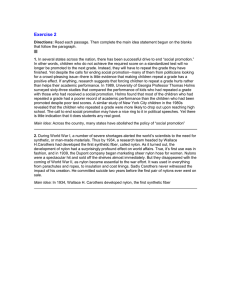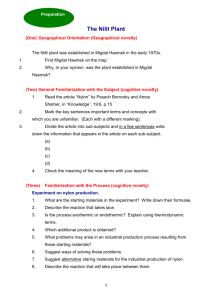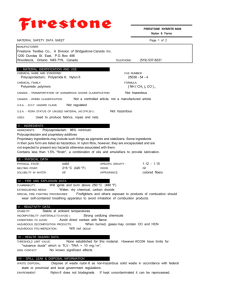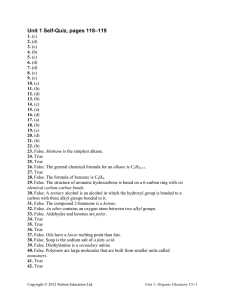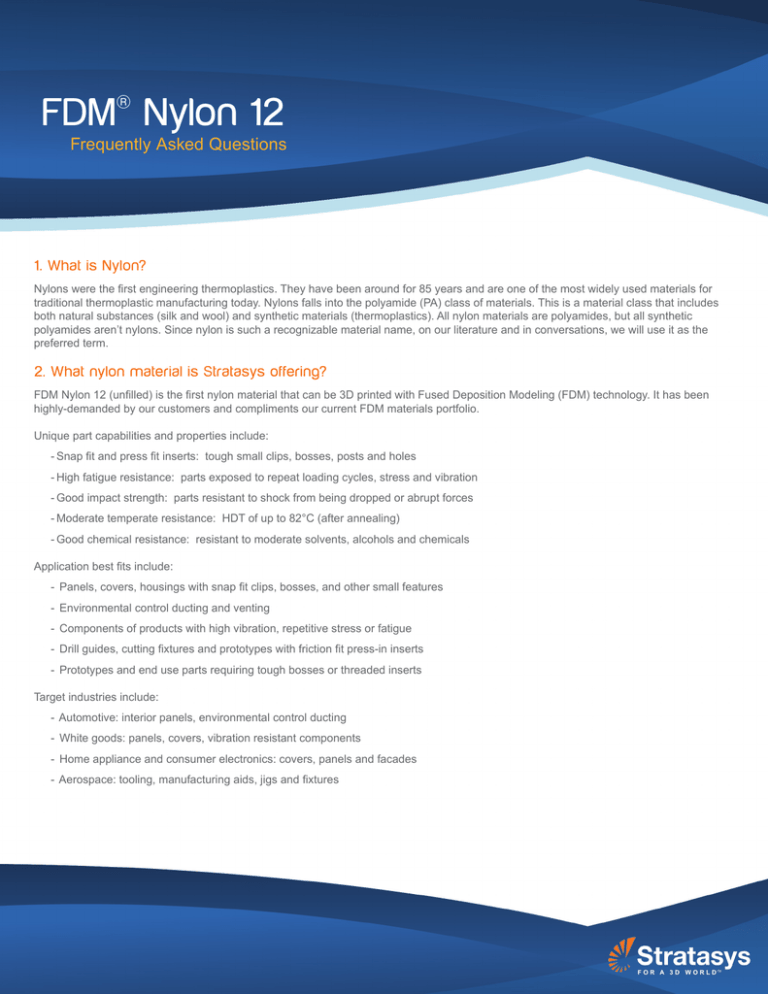
FDM® Nylon 12
Frequently Asked Questions
1. What is Nylon?
Nylons were the first engineering thermoplastics. They have been around for 85 years and are one of the most widely used materials for
traditional thermoplastic manufacturing today. Nylons falls into the polyamide (PA) class of materials. This is a material class that includes
both natural substances (silk and wool) and synthetic materials (thermoplastics). All nylon materials are polyamides, but all synthetic
polyamides aren’t nylons. Since nylon is such a recognizable material name, on our literature and in conversations, we will use it as the
preferred term.
2. What nylon material is Stratasys offering?
FDM Nylon 12 (unfilled) is the first nylon material that can be 3D printed with Fused Deposition Modeling (FDM) technology. It has been
highly-demanded by our customers and compliments our current FDM materials portfolio.
Unique part capabilities and properties include:
-Snap fit and press fit inserts: tough small clips, bosses, posts and holes
-High fatigue resistance: parts exposed to repeat loading cycles, stress and vibration
-Good impact strength: parts resistant to shock from being dropped or abrupt forces
-Moderate temperate resistance: HDT of up to 82°C (after annealing)
-Good chemical resistance: resistant to moderate solvents, alcohols and chemicals
Application best fits include:
- Panels, covers, housings with snap fit clips, bosses, and other small features
- Environmental control ducting and venting
- Components of products with high vibration, repetitive stress or fatigue
- Drill guides, cutting fixtures and prototypes with friction fit press-in inserts
- Prototypes and end use parts requiring tough bosses or threaded inserts
Target industries include:
- Automotive: interior panels, environmental control ducting
- White goods: panels, covers, vibration resistant components
- Home appliance and consumer electronics: covers, panels and facades
- Aerospace: tooling, manufacturing aids, jigs and fixtures
FAQs
3. How does FDM Nylon 12 differ from its competitors?
Stratasys offers a way to produce nylon parts without the complexity and mess of other additive manufacturing processes. In addition, for
many geometries and applications FDM TechnologyTM actually creates nylon parts with higher strength and flexibility when compared to
other additive manufacturing processes.
4. How does FDM Nylon 12 compare to other Stratasys thermoplastics?
Nylon 12 takes additive manufacturing a huge leap forward in terms of toughness compared to our current FDM materials. Toughness is
often determined by how much a material will resist breaking and is commonly measured by elongation at break. FDM Nylon 12 is four to
five times more resistant to break than any other FDM material. In terms of our current materials, Nylon 12 is closest to the material properties of PC-ABS, but it is still much tougher and stronger (tensile strength). In addition, Nylon 12 does have a relatively low Heat Deflection
Temperature (HDT) which makes it unsuitable for high-temperature applications.
Material
Elongation at break
Tensile Strength
HDT
FDM Nylon 12
30%+
7000 psi
82˚C
PC-ABS
6%
5900 psi
110˚C
PC
4.8%
9800 psi
138˚C
5. What does the number mean after “nylon” or “PA”?
The number 12, for example in FDM Nylon 12, indicates that it has 12 carbon atoms. PA stands for polyamide.
This is a distinct material that provides a wide range of mechanical, thermal and chemical properties. According to molders, nylons have the
most diverse range of applications of all thermoplastic polymers.
-Nylon 12 (used in traditional manufacturing methods)
Characterized as a cross-between polyethylene and nylon 6/6
Great elongation at break
Best for fatigue resistance and snap-fits
Tougher and more ductile (less stiff)
Good chemical resistance
Good impact resistance
Traditional manufacturing applications for Nylon 12:
--Friction bearings, housing parts, drill guides, conveyor screw sleeves, friction strips, gear wheels, fan impellors, castors,
impact plates, cutting pads and switch parts
6. What does filled and unfilled mean?
Nylon resins are often mixed with other materials to give the polymer improved mechanical or thermal properties. These would be
considered filled nylon materials. Our FDM Nylon 12 material is an unfilled nylon. It has no added filler. A Nylon 12 CF usually means it is
“carbon filled”, while a Nylon 12 GF means that it is “glass filled”. In the case of carbon-filled, the carbon fibers add increased strength when
compared to its unfilled state. Glass-filled nylons are characterized by providing increased resistance to heat.
FAQs
7. What systems is FDM Nylon 12 available on?
Nylon 12 is available for use on Fortus® 360mc, 400mc and 900mc, eV and ET 3D Production Systems.
8. Is an upgrade required?
A system upgrade is not required to run FDM Nylon 12, however; a material option must be purchased to run FDM Nylon 12.
9. What is the price of the Nylon 12 material option?
The material option is consistent with all other material option prices. Please consult your Fortus price book for the most current pricing.
10. How do you say polyamide?
Polyamide is pronounced paul-ee-am-id.
11. What color is FDM Nylon 12?
FDM Nylon 12 is black.
12. What tips/slice heights can be used?
•0.330mm (0.013”) T20 tip
•0.254mm (0.010”) T16 tip
•0.178mm (0.007”) T12 tip
13. What support material will FDM Nylon 12 use?
SR-110 is a new soluble support material optimized for FDM Nylon 12. The support material will use the T12 SR-100 series tips.
For nylons, time spent in the soluble support removal tank has an added value. Nylon needs some moisture to have its durability properties
optimized. Some parts may seem warped or curled coming out of the machine but will return to their designed shape after soaking in the
tank. FDM Nylon 12 needs to be tanked at a 50° C for small or thin-walled parts to avoid warping.
14. What software and hardware is needed to run FDM Nylon 12?
As with all new material releases, there will be a software upgrade to Insight™ (Insight 9.1 and Backend 3.14) to run FDM Nylon 12. No new
hardware is required to run FDM Nylon 12.
15. Are there any process changes when building and post-processing FDM Nylon 12?
As with any semi-crystalline material there are some best practices that should be followed. They are described in the updated version of
our user guides. Best practices include:
--Build Mode Selection: FDM Nylon 12 has three distinct build modes: thin wall, normal and brick. These modes were designed to help
users create good parts in a variety of geometries. Thin-walled mode is for parts with average wall thicknesses of < 0.10 inches
(0.254mm).
--Sacrificial Part: The sacrificial part uses very little material and significantly improves part quality, seam control and purge strings. It is
strongly recommended to run a sacrificial part. A selection for building a purge part has conveniently been added as an option in Control
Center™ under Pack Options (turn “Include sacrificial tower” to on).
--Part Handling: Because of the material’s sensitivity to heat, FDM Nylon 12 parts should be removed carefully from the machine by
grasping the build sheet and not the part. For delicate parts it’s best to allow the machine to cool to 75° C before removing.
FAQs
--Annealing: FDM Nylon 12 is the first FDM material featuring the ability to improve part properties through an annealing process.
Annealing the parts improves the HDT(from 55˚C → 82˚C), incremental improvement in creep resistance, and slight increase tensile
strength and modulus. Parts can easily be annealed by exposing the part to up to 140° C for up to two hours.
--Support Removal: Nylon 12 has a new support material, SR-110. This material creates a chemical bond with the part material and
should not be removed manually due to the brittleness of the part material at the support/part interface. The support material dissolves
efficiently using the WaterWorks or EcoWorks bath solution. The support removal bath temperature can be set according to the thinnest
walled feature of the part for the most efficient support removal.
Build Mode
Dimension (thinnest wall)
Tank Temperature (C)
Thin Wall
0.1”
50˚C
Normal
0.1” - 0.5”
60˚C
Brick
>0.5”
70˚C
To be safe, a tank temperature of 50˚C can be used for all parts and supports should dissolve overnight (8-12 hours).
16. How much does FDM Nylon 12 cost?
Nylon is priced identical to other FDM thermoplastics like: PC, PC-ABS, and PC-ISO.
17. Does FDM Nylon 12 need conditioning?
To have the best toughness, FDM Nylon 12 parts should be exposed to moisture. The tanking process provides this, but in the event a part
is built without support it would need to be soaked in water to achieve the best part quality and mechanical properties.
Moisture changes the properties and dimensions of all nylons that are machined, molded or produced with FDM.
18. How well do FDM Nylon 12 parts finish?
FDM Nylon 12 parts can be bonded with a variety of cyanoacrylates (super glues), epoxies and polyurethanes.
Depending on geometry and feature size, FDM Nylon 12 parts can be machined and accept bushings, metal press fits and other postbuild additions very well. In addition, the parts can be sanded and tumbled well. Due to its chemical resistance, FDM Nylon 12 parts are
unaffected by vapor smoothing. Thus, they are not compatible with the Finishing TouchTM Smoothing Station.
19. Are there any health and safety concerns with FDM Nylon 12?
Nylon 12 is a widely used material and there are no major health or safety concerns with it or its related support material: SR-110.
Stratasys | www.stratasys.com | info@stratasys.com
7665 Commerce Way
Eden Prairie, MN 55344
+1 888 480 3548 (US Toll Free)
+1 952 937 3000 (Intl)
+1 952 937 0070 (Fax)
2 Holtzman St.
Science Park, PO Box 2496
Rehovot 76124, Israel
+972 74 745-4000
+972 74 745-5000 (Fax)
ISO 9001:2008 Certified
© 2013 Stratasys Inc. All rights reserved. Stratasys and FDM are registered trademarks of Stratasys Inc. FDM Technology, Fused
Deposition Modeling, Stratasys nautilus logo, and “For a 3D World” are trademarks of Stratasys, Inc. All trademarks used by individual
Stratasys product and service groups are the property of Stratasys, Inc. All other trademarks are the property of their respective owners.
Printed in the USA. SSYS-Fortus-Nylon12FAQs-11-13

